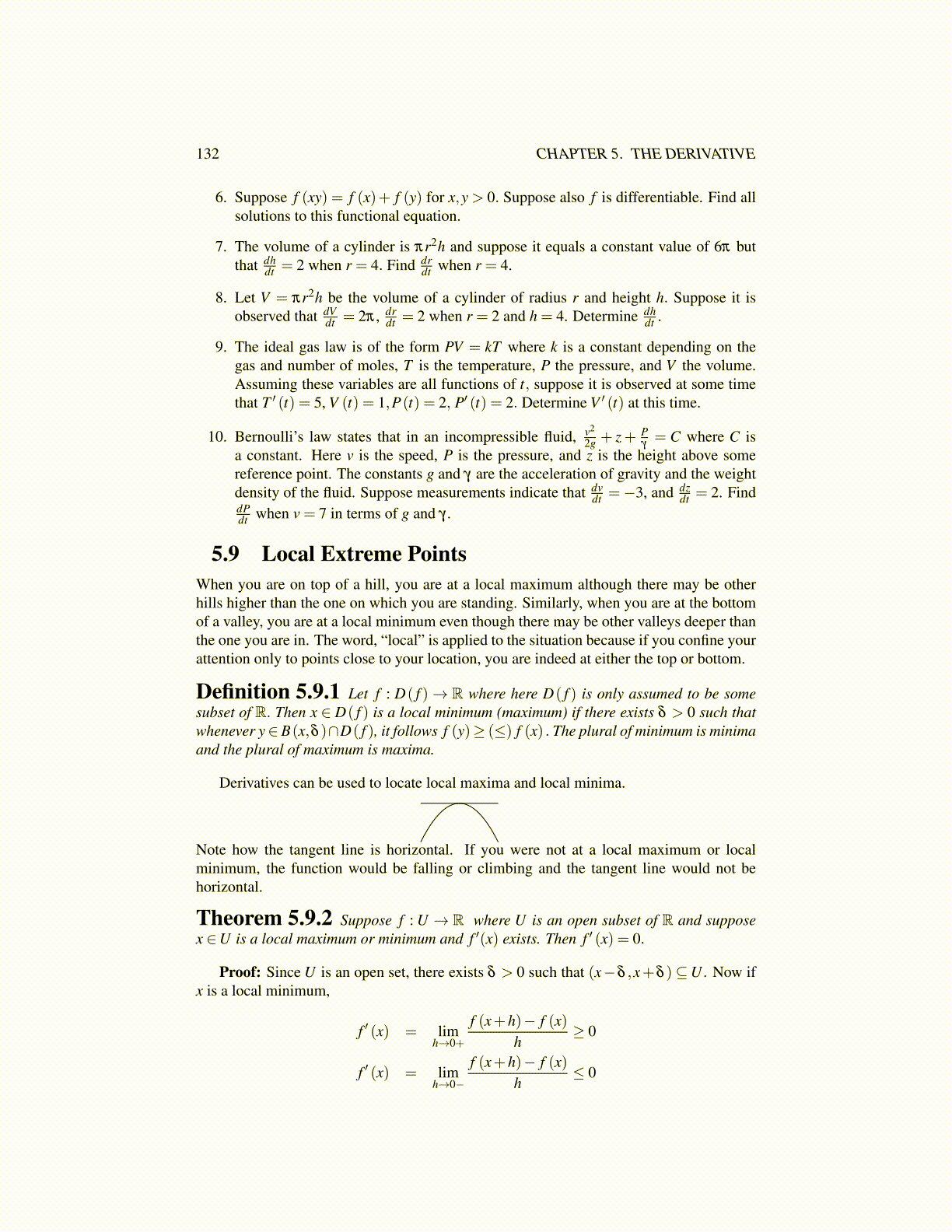
132 CHAPTER 5. THE DERIVATIVE
6. Suppose f (xy) = f (x)+ f (y) for x,y > 0. Suppose also f is differentiable. Find allsolutions to this functional equation.
7. The volume of a cylinder is πr2h and suppose it equals a constant value of 6π butthat dh
dt = 2 when r = 4. Find drdt when r = 4.
8. Let V = πr2h be the volume of a cylinder of radius r and height h. Suppose it isobserved that dV
dt = 2π , drdt = 2 when r = 2 and h = 4. Determine dh
dt .
9. The ideal gas law is of the form PV = kT where k is a constant depending on thegas and number of moles, T is the temperature, P the pressure, and V the volume.Assuming these variables are all functions of t, suppose it is observed at some timethat T ′ (t) = 5, V (t) = 1,P(t) = 2, P′ (t) = 2. Determine V ′ (t) at this time.
10. Bernoulli’s law states that in an incompressible fluid, v2
2g + z+ Pγ= C where C is
a constant. Here v is the speed, P is the pressure, and z is the height above somereference point. The constants g and γ are the acceleration of gravity and the weightdensity of the fluid. Suppose measurements indicate that dv
dt =−3, and dzdt = 2. Find
dPdt when v = 7 in terms of g and γ .
5.9 Local Extreme PointsWhen you are on top of a hill, you are at a local maximum although there may be otherhills higher than the one on which you are standing. Similarly, when you are at the bottomof a valley, you are at a local minimum even though there may be other valleys deeper thanthe one you are in. The word, “local” is applied to the situation because if you confine yourattention only to points close to your location, you are indeed at either the top or bottom.
Definition 5.9.1 Let f : D( f ) → R where here D( f ) is only assumed to be somesubset of R. Then x ∈ D( f ) is a local minimum (maximum) if there exists δ > 0 such thatwhenever y∈B(x,δ )∩D( f ), it follows f (y)≥ (≤) f (x) . The plural of minimum is minimaand the plural of maximum is maxima.
Derivatives can be used to locate local maxima and local minima.
Note how the tangent line is horizontal. If you were not at a local maximum or localminimum, the function would be falling or climbing and the tangent line would not behorizontal.
Theorem 5.9.2 Suppose f : U → R where U is an open subset of R and supposex ∈U is a local maximum or minimum and f ′(x) exists. Then f ′ (x) = 0.
Proof: Since U is an open set, there exists δ > 0 such that (x−δ ,x+δ )⊆U . Now ifx is a local minimum,
f ′ (x) = limh→0+
f (x+h)− f (x)h
≥ 0
f ′ (x) = limh→0−
f (x+h)− f (x)h
≤ 0